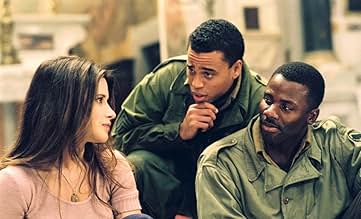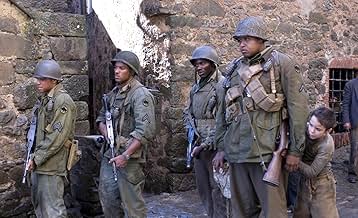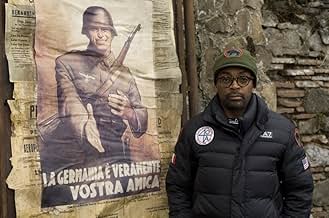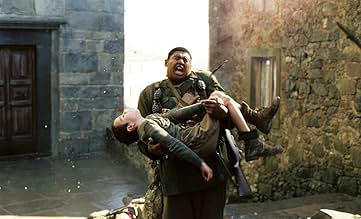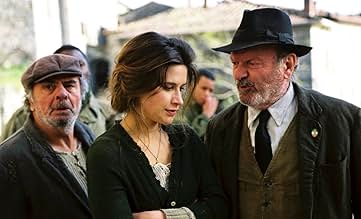CALIFICACIÓN DE IMDb
6.1/10
20 k
TU CALIFICACIÓN
Ambientada en la Italia de 1944, narra la historia de cuatro soldados negros estadounidenses atrapados en un pueblo toscano durante la Segunda Guerra Mundial.Ambientada en la Italia de 1944, narra la historia de cuatro soldados negros estadounidenses atrapados en un pueblo toscano durante la Segunda Guerra Mundial.Ambientada en la Italia de 1944, narra la historia de cuatro soldados negros estadounidenses atrapados en un pueblo toscano durante la Segunda Guerra Mundial.
- Premios
- 1 premio ganado y 10 nominaciones en total
Lidia Biondi
- Natalina
- (as Lydia Biondi)
Opiniones destacadas
I attended the world premier of Miracle at St. Anna at Toronto International Film Festival. Unfortunately as much as I respect Spike Lee as a filmmaker I thought the movie was a bit dull and kind of boring. At 166 minutes I found that the movie was overlong and dragged too much. I became restless after awhile as the movie progressed. The story didn't seem to go anywhere, was uninteresting and I had trouble connecting with it. It was hard to follow at times as well. The movie jumped all over the place at several points to different years in the history of the characters. I found this to be jarring and irritating. Spike Lee should have taken more time to edit his film because each of the scenes went longer than they should have. It's not the worst movie I have ever seen although it could have been better. My expectations were high. I came away somewhat disappointed.
A funny thing happens when you're counted among the preeminent talents in any contemporary art form: Everything you do must approach sublime... or else. Something less funny happens when your art is as socially outspoken as Spike Lee's body of work: Folk wait with baited breath to name every shred of detail that marks your work as somehow less than sublime. And in so doing, they ever miss the forest for the trees.
Lee's latest "joint," MIRACLE AT ST. ANNA, based on James McBride's novel of the same name, no doubt will suffer from such deconstruction, some of which will be justified. At 160+ minutes, the fictional recollection of four black American WWII soldiers who get trapped in an Italian village during a German insurgence, can wax tedious. And Lee's defaulting to certain conventions of the war genre and his own signature style occasionally comes off forced, sentimental, even ridiculous. After, say, the 10th close-up of a slain human -- eyes still open in horror -- we may not need to see an 11th, 12th, 13th. And any casual student of cinema might spot Lee's attempted tear-jerker ending a la CINEMA PARADISO coming a mile away.
Then there are the technical shortcomings of personnel who should know better: A score by Terence Blanchard is uncharacteristically overwrought; cinematography by Matthew Libatique is alternately breathtaking and obtuse; and a self-adapted screenplay by McBride suffers from a conspicuously uncommitted point of view. But, indeed, what may most undercut any visceral charm of MASA is at once admirably realistic: The film's characters aren't particularly moving in their conflicted natures and utter lack of romance. Only a visionary Italian boy, played beautifully by newcomer Matteo Sciabordi, and the black American soldier who befriends him, played by the hulking Omar Benson Miller, elicit any real sympathy.
All told, the numerous missteps do not seriously undercut a captive tale of humans -- white, black and brown -- who find themselves thrown into a hell not of their making and forced to juggle universal sensibilities with the duties of their divergent identities. In this regard, Lee's latest shows marked progress: Gone are the one-sided depictions of whites. Fascist-era native Italians are shown here in all their warring complexity; American actor D.B. Sweeney plays a key, if understated, role as a white U.S. colonel opposed to the exploitation of the all-black 92nd Army Division; even Nazi stormtroopers here are given back a modicum of humanity. Neither is the African American experience sanctified: Actor Michael Ealy's preacher-turned-soldier character is equal parts charming and vile; and one pre-Civil Rights-era American flashback begs the question of what line separates hero and villain. If one is willing to forgive the imperfect details from a filmmaker who has proved capable of better, the aggregate statement is hardly ineffectual.
Lee's real victory here shouldn't be missed. MASA does not rise to the level of the best of the genre. Neither is it worthy to be called the definitive tribute to an unsung 92nd Army Division or the souls lost at Sant'Anna di Stazzema. But it is always watchable, always interesting -- and as an engaging enough mystery film and thoughtful ensemble piece with an important, forgotten corner of human failure as backdrop, it succeeds.
Lee's latest "joint," MIRACLE AT ST. ANNA, based on James McBride's novel of the same name, no doubt will suffer from such deconstruction, some of which will be justified. At 160+ minutes, the fictional recollection of four black American WWII soldiers who get trapped in an Italian village during a German insurgence, can wax tedious. And Lee's defaulting to certain conventions of the war genre and his own signature style occasionally comes off forced, sentimental, even ridiculous. After, say, the 10th close-up of a slain human -- eyes still open in horror -- we may not need to see an 11th, 12th, 13th. And any casual student of cinema might spot Lee's attempted tear-jerker ending a la CINEMA PARADISO coming a mile away.
Then there are the technical shortcomings of personnel who should know better: A score by Terence Blanchard is uncharacteristically overwrought; cinematography by Matthew Libatique is alternately breathtaking and obtuse; and a self-adapted screenplay by McBride suffers from a conspicuously uncommitted point of view. But, indeed, what may most undercut any visceral charm of MASA is at once admirably realistic: The film's characters aren't particularly moving in their conflicted natures and utter lack of romance. Only a visionary Italian boy, played beautifully by newcomer Matteo Sciabordi, and the black American soldier who befriends him, played by the hulking Omar Benson Miller, elicit any real sympathy.
All told, the numerous missteps do not seriously undercut a captive tale of humans -- white, black and brown -- who find themselves thrown into a hell not of their making and forced to juggle universal sensibilities with the duties of their divergent identities. In this regard, Lee's latest shows marked progress: Gone are the one-sided depictions of whites. Fascist-era native Italians are shown here in all their warring complexity; American actor D.B. Sweeney plays a key, if understated, role as a white U.S. colonel opposed to the exploitation of the all-black 92nd Army Division; even Nazi stormtroopers here are given back a modicum of humanity. Neither is the African American experience sanctified: Actor Michael Ealy's preacher-turned-soldier character is equal parts charming and vile; and one pre-Civil Rights-era American flashback begs the question of what line separates hero and villain. If one is willing to forgive the imperfect details from a filmmaker who has proved capable of better, the aggregate statement is hardly ineffectual.
Lee's real victory here shouldn't be missed. MASA does not rise to the level of the best of the genre. Neither is it worthy to be called the definitive tribute to an unsung 92nd Army Division or the souls lost at Sant'Anna di Stazzema. But it is always watchable, always interesting -- and as an engaging enough mystery film and thoughtful ensemble piece with an important, forgotten corner of human failure as backdrop, it succeeds.
MIRACLE AT ST. ANNA got panned pretty severely. And I can see why. Lacking cohesion and hopscotching around like a child with A-D-D, the story is tough to follow. And what about the title? Exactly what is "the Miracle"? Some might say it's that this film ever got made. But there are some upsides to it that I think make this a semi-watchable flick.
The first plus is that it focuses on a little known regiment of black WW II fighters called "The Buffalo Soldiers." Spike Lee had apparently been aching to do another "black story" and found his muse in Nazi occupied Italy.
Although there's been some bashing related to overacting on the main characters' parts, I didn't find that to be the case. Derek Luke, Michael Ealy, and the rest of these band of brothers did fine in my eyes. Although Spike did have them doing things that weren't being done during this time (specifically the "high five" which wasn't realized until the late 70s), I did find their delivery of the story to be engaging enough, and kept me watching during its entire, lengthy, 2 hours and 40 minute run time.
I also really liked the on-site filming locations in Italy, which gave the entire production a very real quality. The cobbled streets, twisted landscape, and ancient-looking buildings were all well-shown in the film and had me ogling at various times.
But, as they say, all good things must come to an end. Although Spike Lee tries admirably to keep the story together, he too often wanders off on tangents that have nothing to do with the story. One particularly infuriating scene involves John Leguizamo (THE HAPPENING). He's in modern day Italy with his lover and his only use for being in the film is that he throws a newspaper out a window so that it lands on a man's table. Why couldn't the man have simply seen it at a newsstand? Why the whole set up with Leguizamo and the hot chick? Sex for the sake of sex, perhaps? The other, less infuriating, item that shows Spike wandering away was when he films the Buffalo boys being refused food service at a place back in the States before they were shipped overseas. Why this played a role in the film and what it had to do with the Miracle is anyone's guess.
Finally, there's the tough sell of the Miracle itself. Although people can debate what qualifies as a miracle, I think most would say it equates to something supernatural that cannot be explained by normal evidence. And here lies perhaps the biggest problem for Miracle at St. Anna. There really isn't a miracle. Perhaps it's well enough that one of the Buffalo men made it home and found his way to peace. Perhaps it's that the world spun and allowed the last surviving Buffalo Soldier to avenge the people of St. Anna and his fallen brothers. Perhaps ...but not likely.
The first plus is that it focuses on a little known regiment of black WW II fighters called "The Buffalo Soldiers." Spike Lee had apparently been aching to do another "black story" and found his muse in Nazi occupied Italy.
Although there's been some bashing related to overacting on the main characters' parts, I didn't find that to be the case. Derek Luke, Michael Ealy, and the rest of these band of brothers did fine in my eyes. Although Spike did have them doing things that weren't being done during this time (specifically the "high five" which wasn't realized until the late 70s), I did find their delivery of the story to be engaging enough, and kept me watching during its entire, lengthy, 2 hours and 40 minute run time.
I also really liked the on-site filming locations in Italy, which gave the entire production a very real quality. The cobbled streets, twisted landscape, and ancient-looking buildings were all well-shown in the film and had me ogling at various times.
But, as they say, all good things must come to an end. Although Spike Lee tries admirably to keep the story together, he too often wanders off on tangents that have nothing to do with the story. One particularly infuriating scene involves John Leguizamo (THE HAPPENING). He's in modern day Italy with his lover and his only use for being in the film is that he throws a newspaper out a window so that it lands on a man's table. Why couldn't the man have simply seen it at a newsstand? Why the whole set up with Leguizamo and the hot chick? Sex for the sake of sex, perhaps? The other, less infuriating, item that shows Spike wandering away was when he films the Buffalo boys being refused food service at a place back in the States before they were shipped overseas. Why this played a role in the film and what it had to do with the Miracle is anyone's guess.
Finally, there's the tough sell of the Miracle itself. Although people can debate what qualifies as a miracle, I think most would say it equates to something supernatural that cannot be explained by normal evidence. And here lies perhaps the biggest problem for Miracle at St. Anna. There really isn't a miracle. Perhaps it's well enough that one of the Buffalo men made it home and found his way to peace. Perhaps it's that the world spun and allowed the last surviving Buffalo Soldier to avenge the people of St. Anna and his fallen brothers. Perhaps ...but not likely.
Let me begin by saying that this movie was okay. But it could have been way better.
The story itself is great and kept me interested until the end, but it's execution could have been much better. Throughout the movie, some of the acting ranged from good to bad to downright lame. Jon Turturro's cameo as a detective was extremely disappointing, for instance. The acting picks up when the flashback begins, but every so often it rockets down.
The battle scenes were, for lack of a better word, comical. They were over the top and stereotypical of any other war movie, complete with bodies being flung from explosions in an exaggerated fashion and people sobbing over amputated rubber limbs.
The characters were all over the place on the sympathy scale. Stamps and Trey (or is it Train?) elicit plenty of sympathy, whereas Bishop and whatever the girl's name was only brought out anger from me.
The worst part of the movie is the editing, though. Some of the battle scenes are choppy, and there are entire cuts to different scenes for split seconds that we could have done without (they serve no purpose whatsoever).
My biggest problem was the stereotypical racism of the white characters in the movie. The only American white people in the movie are shown as black-hating jerks who's ignorance leads them to destruction.
Overall, the movie was good. Not amazing, not great, definitely not a masterpiece, but it wasn't terrible or bad or crappy. It was a great story, but it could have been executed much better.
6.5 Stars.
The story itself is great and kept me interested until the end, but it's execution could have been much better. Throughout the movie, some of the acting ranged from good to bad to downright lame. Jon Turturro's cameo as a detective was extremely disappointing, for instance. The acting picks up when the flashback begins, but every so often it rockets down.
The battle scenes were, for lack of a better word, comical. They were over the top and stereotypical of any other war movie, complete with bodies being flung from explosions in an exaggerated fashion and people sobbing over amputated rubber limbs.
The characters were all over the place on the sympathy scale. Stamps and Trey (or is it Train?) elicit plenty of sympathy, whereas Bishop and whatever the girl's name was only brought out anger from me.
The worst part of the movie is the editing, though. Some of the battle scenes are choppy, and there are entire cuts to different scenes for split seconds that we could have done without (they serve no purpose whatsoever).
My biggest problem was the stereotypical racism of the white characters in the movie. The only American white people in the movie are shown as black-hating jerks who's ignorance leads them to destruction.
Overall, the movie was good. Not amazing, not great, definitely not a masterpiece, but it wasn't terrible or bad or crappy. It was a great story, but it could have been executed much better.
6.5 Stars.
Length is a factor for this film, and it's not the normal action driven war film. I was lucky enough to attend the premier in NY and from the perspective of a Cadet at West Point, I would say that I respected this film BECAUSE it "jumped around." It showed all perspectives and that there were people with good intentions on all sides. The bad intentions were included as well, and though it doesn't grab you the entire time, it tells an interesting tale. Sadly, most people don't go to see a war film for this reasons, they all want Saving Private Ryan these days. But that's not what war is always about, and this film shows the other aspects. The black soldiers are each equally representative of varying perspectives that these men had. With a lot of duality also represented, this film leaves a lot to think about if you watch it with the right eye. It seems most people I've talked to have a problem with length and action, but if you don't pay so much attention to that and just enjoy it, you'll find a nice film that takes a different approach.
¿Sabías que…?
- TriviaSamuel L. Jackson turned down the offer to play as Corporal Hector Negron to work on Vecinos en la mira (2008).
- ErroresWhen the professor examines the marble head he recognizes it as the "Primavera" from Santa Trinità in Florence. He assumes it is by Bartolomeo Ammannati, but the bridge is by Ammannati; the sculpture is by Pietro Francavilla.
- Citas
Livingston: Safety is the greatest risk of all, because safety leaves no room for miracles and miracles are the only sure thing in life.
- Bandas sonorasFaccetta Nera
Written by Gustavo Cacini (as Cascini) / Giuseppe Micheli (as Micheli) / Vincenzo Raimondi / Arnaldo Stazzonelli (as Stazzonelli)
Edizioni Bixio C.E.M.S.A.
Selecciones populares
Inicia sesión para calificar y agrega a la lista de videos para obtener recomendaciones personalizadas
Detalles
- Fecha de lanzamiento
- Países de origen
- Sitio oficial
- Idiomas
- También se conoce como
- Untitled Spike Lee WWII Project
- Locaciones de filmación
- Productoras
- Ver más créditos de la compañía en IMDbPro
Taquilla
- Presupuesto
- USD 45,000,000 (estimado)
- Total en EE. UU. y Canadá
- USD 7,919,117
- Fin de semana de estreno en EE. UU. y Canadá
- USD 3,477,996
- 28 sep 2008
- Total a nivel mundial
- USD 9,333,654
- Tiempo de ejecución2 horas 40 minutos
- Color
- Mezcla de sonido
- Relación de aspecto
- 2.39 : 1
Contribuir a esta página
Sugiere una edición o agrega el contenido que falta







